Part II. Simple CNN plus land mask and season#
Author: Eli Holmes (NOAA), Yifei Hang (UW Varanasi intern 2024), Jiarui Yu (UW Varanasi intern 2023)
In Part II, we will add two components to help the model: the land/ocean mask as an input (training variable) so the model can learn the land/ocean boundary and so we can use a custom loss function to tell the model not to train on the y (CHL) that is over land since those are not real data. We will also add season to the model so that the model can use different feature weightings for different times of the year.
Our new model has spatial variables, seasonal variables, and an ocean mask (categorical).
Our data is in Google Object Storage.
Variables in the model#
Feature |
Spatial Variation |
Temporal Variation |
Notes |
|---|---|---|---|
|
✅ Varies by lat/lon |
✅ Varies by time |
Numeric, normalize |
|
✅ Varies by lat/lon |
✅ Varies by time |
Numeric, normalize |
|
❌ Same across lat/lon |
✅ Varies by time |
Cyclical, do not normalize |
|
❌ Same across lat/lon |
✅ Varies by time |
Cyclical, do not normalize |
|
✅ Varies by lat/lon |
❌ Static |
Binary (0=land, 1=ocean), do not normalize |
|
✅ Varies by lat/lon |
✅ Varies by time |
Numeric, maybe normalize |
sstandso: These are our core spatial-temporal features. The CNN will learn spatial filters to extract patterns over ocean and time.sin_timeandcos_time: These introduce seasonality into our model. The CNN can learn seasonally dependent patterns, e.g., chlorophyll blooms in spring. Thesin_timeandcos_timefeatures are designed to represent seasonality using a cyclical encoding. Normalizing these features (e.g., to mean 0, std 1) would distort their circular geometry and defeat their intended purpose.ocean_mask: This acts like a location-aware binary filter. It tells the CNN which pixels are land (0) vs ocean (1), which helps avoid learning patterns over invalid/land areas.y(response): The model trains on this. We have logged it and it is roughly centered near 0. We need to evaluate whether our response has areas with much much higher variance than other areas. If so, we need to do some spatial normalization so our model doesn’t only learn the high variance areas.
Load the libraries#
# Uncomment this line and run if you are in Colab; leave in the !. That is part of the cmd
# !pip install zarr gcsfs --quiet
# --- Core data handling libraries ---
import xarray as xr # for working with labeled multi-dimensional arrays
import numpy as np # for numerical operations on arrays
import dask.array as da # for lazy, parallel array operations (used in xarray backends)
# --- Plotting ---
import matplotlib.pyplot as plt # for creating plots
# --- TensorFlow setup ---
import os
os.environ['TF_CPP_MIN_LOG_LEVEL'] = '2' # suppress TensorFlow log spam (0=all, 3=only errors)
import tensorflow as tf # main deep learning framework
# --- Keras (part of TensorFlow): building and training neural networks ---
from keras.models import Sequential # lets us stack layers in a simple linear model
from keras.layers import Conv2D # 2D convolution layer — finds spatial patterns in image-like data
from keras.layers import BatchNormalization # stabilizes and speeds up training by normalizing activations
from keras.layers import Dropout # randomly "drops" neurons during training to reduce overfitting
from keras.callbacks import EarlyStopping # stops training early if validation loss doesn't improve
2025-06-19 01:43:37.121112: E external/local_xla/xla/stream_executor/cuda/cuda_fft.cc:485] Unable to register cuFFT factory: Attempting to register factory for plugin cuFFT when one has already been registered
2025-06-19 01:43:37.138378: E external/local_xla/xla/stream_executor/cuda/cuda_dnn.cc:8454] Unable to register cuDNN factory: Attempting to register factory for plugin cuDNN when one has already been registered
2025-06-19 01:43:37.143644: E external/local_xla/xla/stream_executor/cuda/cuda_blas.cc:1452] Unable to register cuBLAS factory: Attempting to register factory for plugin cuBLAS when one has already been registered
See what machine we are on#
# list all the physical devices
physical_devices = tf.config.list_physical_devices()
print("All Physical Devices:", physical_devices)
# list all the available GPUs
gpus = tf.config.list_physical_devices('GPU')
print("Available GPUs:", gpus)
# Print infomation for available GPU if there exists any
if gpus:
for gpu in gpus:
details = tf.config.experimental.get_device_details(gpu)
print("GPU Details:", details)
else:
print("No GPU available")
All Physical Devices: [PhysicalDevice(name='/physical_device:CPU:0', device_type='CPU'), PhysicalDevice(name='/physical_device:GPU:0', device_type='GPU')]
Available GPUs: [PhysicalDevice(name='/physical_device:GPU:0', device_type='GPU')]
GPU Details: {'compute_capability': (7, 5), 'device_name': 'Tesla T4'}
Load data#
I created the data for Part II in Data_Prep_CNN and uploaded to a Google storage bucket. Here I will load. The dataset goes from 1997 to 2022, however there is no salinity data after 2020.
sst, so, sin_time, cos_time
ocean_mask
y (CHL)
# load full dataset 1997 to 2022 from Google bucket
# If loading from disk, use this dataset = xr.open_zarr("~/shared/cnn/part2.zarr")
# Replace ~/shared/cnn/part2.zarr with the actual file location
dataset = xr.open_dataset(
"gcs://nmfs_odp_nwfsc/CB/mind_the_chl_gap/cnn_tutorial",
engine="zarr",
backend_kwargs={"storage_options": {"token": "anon"}},
consolidated=True
)
dataset
<xarray.Dataset> Size: 5GB
Dimensions: (time: 9207, lat: 149, lon: 181)
Coordinates:
* lat (lat) float32 596B 32.0 31.75 31.5 31.25 ... -4.5 -4.75 -5.0
* lon (lon) float32 724B 45.0 45.25 45.5 45.75 ... 89.5 89.75 90.0
* time (time) datetime64[ns] 74kB 1997-10-01 1997-10-02 ... 2022-12-31
Data variables:
cos_time (time, lat, lon) float32 993MB ...
ocean_mask (lat, lon) float32 108kB ...
sin_time (time, lat, lon) float32 993MB ...
so (time, lat, lon) float32 993MB ...
sst (time, lat, lon) float32 993MB ...
topo (lat, lon) float32 108kB ...
y (time, lat, lon) float32 993MB ...Create function for to process the data for training and testing#
Split data randomly into train, validate, and test pools
Normalize the data using training numerical input variables (SST and salinity)
Replace NaNs with 0.
Return stacked Numpy arrays. Note these will “lazy” (dask arrays) if we pass in lazy dask arrays.
We need to normalize (mean zero, variance of 1) our numerical input variables but we need to compute the normalization metrics (X_mean and X_std) from the training data only. Otherwise we would have “data leakage”; information from the data we are predicting (not using for training) is used in testing or validation.
import numpy as np
import dask.array as da
def time_series_split(data, num_var, cat_var=None, split_ratio=(0.7, 0.2, 0.1), seed=42,
X_mean=None, X_std=None):
"""
Splits time indices randomly into train/val/test. Replaces NaNs with 0s.
Normalizes numerical variables only, using either provided or training-set mean/std.
Parameters:
data: xarray dataset with 'time' dimension; for memory efficiency use a dask array
num_var: list of numerical variable names (to normalize)
cat_var: list of categorical variable names (no normalization)
split_ratio: tuple (train, val, test), must sum to 1.0
seed: random seed
X_mean, X_std: optional mean/std arrays for num_var only (shape = [n_num_vars])
Returns:
X, y: full input and label arrays (Dask arrays)
X_train, y_train, X_val, y_val, X_test, y_test: split data
X_mean, X_std: mean and std used for normalization
"""
if cat_var is None:
cat_var = []
input_var = num_var + cat_var
time_dim = "time"
if time_dim not in data.dims:
raise ValueError("Dataset must contain a 'time' dimension.")
time_len = data.sizes[time_dim]
rng = np.random.default_rng(seed)
all_indices = rng.choice(time_len, size=time_len, replace=False)
# Compute indices for splitting data into train, validate, and test
train_end = int(split_ratio[0] * time_len)
val_end = int((split_ratio[0] + split_ratio[1]) * time_len)
train_idx = np.sort(all_indices[:train_end])
val_idx = np.sort(all_indices[train_end:val_end])
test_idx = np.sort(all_indices[val_end:])
# Separate lists for raw (with NaNs) and pre-filled arrays
num_arrays_raw = []
cat_arrays = []
for var in input_var:
arr = data[var]
if time_dim not in arr.dims:
arr = arr.expand_dims({time_dim: data["time"]})
arr = arr.broadcast_like(data["sst"])
arr = arr.transpose(time_dim, ...) # (time, lat, lon)
if var in num_var:
num_arrays_raw.append(arr.data) # keep NaNs for now
else:
arr_data = da.nan_to_num(arr.data) # fill NaNs with 0 for cat vars
cat_arrays.append(arr_data)
# Stack numerical variables (with NaNs still present)
X_num_raw = da.stack(num_arrays_raw, axis=-1) if num_arrays_raw else None
X_cat = da.stack(cat_arrays, axis=-1) if cat_arrays else None
# Compute or apply normalization; compute mean and std from training data
if X_num_raw is not None:
if X_mean is not None and X_std is not None:
X_std_safe = da.where(X_std == 0, 1.0, X_std)
elif split_ratio[0] > 0.0:
X_train_temp = X_num_raw[train_idx]
X_mean = da.nanmean(X_train_temp, axis=(0, 1, 2)).compute()
X_std = da.nanstd(X_train_temp, axis=(0, 1, 2)).compute()
X_std_safe = da.where(X_std == 0, 1.0, X_std)
else:
raise ValueError("Must provide X_mean and X_std if no training data available")
# Normalize and fill NaNs with 0 after normalization
# All data is normalized with the X_mean and X_std from training data
X_num = (X_num_raw - X_mean) / X_std_safe
X_num = da.nan_to_num(X_num)
else:
X_num = None
# Combine all inputs
if X_num is not None and X_cat is not None:
X = da.concatenate([X_num, X_cat], axis=-1)
elif X_num is not None:
X = X_num
elif X_cat is not None:
X = X_cat
else:
raise ValueError("No input variables provided.")
# Prepare label (always fill NaNs in label)
y = da.nan_to_num(data["y"].transpose(time_dim, ...).data)
# Prep the train, val and test; return empty dask array if split ratio is 0
X_train = X[train_idx]
y_train = y[train_idx]
X_val = X[val_idx]
y_val = y[val_idx]
X_test = X[test_idx]
y_test = y[test_idx]
return X, y, X_train, y_train, X_val, y_val, X_test, y_test, X_mean, X_std
Create training data on 2020#
Here we create our training and test data with 2 variables using only 2020. 70% data for training, 20% for validation and 10% for testing.
Remove days with too many NaN.
# Load 2020 for training
data_xr = dataset.sel(time="2020")
# Check how many NaNs that we have
# Broadcast to 3D: (time, lat, lon) since it is 2D now
mask_3d = data_xr["ocean_mask"].astype(bool).broadcast_like(data_xr["sst"])
# Count NaNs over ocean only
for var in ["sst", "so", "y"]:
var_data = data_xr[var]
ocean_nan = var_data.isnull() & mask_3d # Use xarray's isnull()
max_nan = ocean_nan.sum(dim=["lat", "lon"]).max().compute()
print(f"{var}: max ocean NaNs per time step = {int(max_nan)}")
sst: max ocean NaNs per time step = 0
so: max ocean NaNs per time step = 79
y: max ocean NaNs per time step = 1602
nan_thresh = 0.05 * data_xr["ocean_mask"].sum().values
nan_thresh
832.0500000000001
mask_3d = data_xr["ocean_mask"].astype(bool).broadcast_like(data_xr["sst"])
# Count missing CHL values over ocean for each time step in CHL
chl_nan = np.isnan(data_xr["y"]) & mask_3d
chl_nan_count = chl_nan.sum(dim=["lat", "lon"])
# Set threshold: exclude days with too much missing CHL
valid_times = chl_nan_count < nan_thresh
# Apply time filtering
data_xr = data_xr.sel(time=valid_times)
print(f"Remaining days after CHL filtering: {data_xr.sizes['time']}")
Remaining days after CHL filtering: 321
Return the stacked Numpy arrays#
Technically these are dask arrays, still lazy loaded, since data_xr is a lazy dask array. They are not loaded into memory until we prepare them for TensorFlow with tf.data.Dataset.from_tensor_slices().
# only normalize num_var
num_var = ['sst', 'so']
cat_var = ['ocean_mask', 'sin_time', 'cos_time']
split_ratio = [.7, .2, .1]
X, y, X_train, y_train, X_val, y_val, X_test, y_test, X_mean, X_std = time_series_split(data_xr, num_var, cat_var, split_ratio)
# X is still lazy loaded; dask array is lazy, not in memory yet
type(X)
dask.array.core.Array
Create the CNN model#
from keras.models import Sequential
from keras.layers import Input, Conv2D, BatchNormalization, Dropout
def create_model_CNN(input_shape):
"""
Create a simple 3-layer CNN model for gridded ocean data.
Parameters
----------
input_shape : tuple
The shape of each sample, e.g., (149, 181, 2)
Returns
-------
model : keras.Model
CNN model to predict CHL from SST and salinity
"""
model = Sequential()
# Input layer defines the input dimensions for the CNN
model.add(Input(shape=input_shape))
# Layer 1 — learns fine-scale 3x3 spatial features
# Let the model learn 64 different patterns (filters) in the data at this layer.
# activation relu is non-linearity
model.add(Conv2D(filters=64, kernel_size=(3, 3), padding='same', activation='relu'))
model.add(BatchNormalization())
model.add(Dropout(0.2))
# Layer 2 — expands context to 5x5; combines fine features into larger structures
# Reduce the number of patterns (filters) so we gradually reduce model complexity
model.add(Conv2D(filters=32, kernel_size=(3, 3), padding='same', activation='relu'))
model.add(BatchNormalization())
model.add(Dropout(0.2))
# Layer 3 — has access to ~7x7 neighborhood; outputs CHL prediction per pixel
# Combines all the previous layer’s features into a CHL estimate at each pixel
# 1 response (chl) — hence, 1 prediction pixel = filter
# linear since predicting a real continuous variable (log CHL)
model.add(Conv2D(filters=1, kernel_size=(3, 3), padding='same', activation='linear'))
return model
Create a custom loss function so don’t train on land#
# Load ocean mask from dataset and convert to numpy
# Assumes ocean_mask is (lat, lon)
ocean_mask = data_xr['ocean_mask'].values.astype(np.float32)
import tensorflow as tf
# Convert once and reuse — do *not* redefine inside the loss function!
ocean_mask_tf = tf.convert_to_tensor(ocean_mask)[tf.newaxis, ..., tf.newaxis] # shape (1, lat, lon, 1)
def masked_mae(y_true, y_pred):
if y_true.shape.rank == 3:
y_true = tf.expand_dims(y_true, axis=-1)
if y_pred.shape.rank == 3:
y_pred = tf.expand_dims(y_pred, axis=-1)
masked_diff = tf.abs(y_true - y_pred) * ocean_mask_tf
return tf.reduce_sum(masked_diff) / tf.reduce_sum(ocean_mask_tf)
Let’s build the model#
We build a simple 3-layer CNN model. Each layer preserves the (lat, lon) shape and learns filters to extract spatial patterns. The model has ~20,000 trainable parameters, which we can see from model.summary(). This is small compared to huge modern CNNs (millions of parameters).
First let’s look at the input shape of our data. We are passing it the whole region.
X_train.shape[1:]
(149, 181, 5)
Even though each convolution is local (3×3, 5×5), the input is always the full spatial extent, so the model can learn things like: “CHL is high in this particular location of the map when SST, salinity, seasonal are such and such”. In part III, we will use smaller patches to help the model learn general patterns: “CHL is high where this type of temperature/salinity/seasonal pattern exists, no matter where on the map it occurs”.
# Get shape of one input sample: (lat, lon, n_features)
input_shape = X_train.shape[1:]
# Create the model using the correct input shape
model = create_model_CNN(input_shape)
# Check the model summary
# model.summary()
Let’s train the model#
# Compile the model with Adam optimizer and mean absolute error (MAE) as both loss and evaluation metric
model.compile(
optimizer='adam', # Efficient and widely used optimizer
loss=masked_mae, # Mean Absolute Error: good for continuous data like CHL
metrics=[masked_mae] # Also track MAE during training/validation
)
# If you want to use mae (train over land) then use this
# model.compile(optimizer='adam', loss='mae', metrics=['mae'])
# Set up early stopping to prevent overfitting
early_stop = EarlyStopping(
patience=10, # Stop if validation loss doesn't improve for 10 epochs
restore_best_weights=True # Revert to the model weights from the best epoch
)
# Create a TensorFlow dataset for training
train_dataset = tf.data.Dataset.from_tensor_slices((X_train, y_train))
train_dataset = train_dataset.shuffle(buffer_size=1024) # Shuffle the data (helps generalization)
train_dataset = train_dataset.batch(8) # Batch size = 8
# Create a TensorFlow dataset for validation (no shuffle)
val_dataset = tf.data.Dataset.from_tensor_slices((X_val, y_val))
val_dataset = val_dataset.batch(8)
# Train the model
history = model.fit(
train_dataset,
epochs=50, # Maximum number of training epochs
validation_data=val_dataset, # Use validation data during training
callbacks=[early_stop] # Stop early if no improvement
)
Epoch 1/50
28/28 ━━━━━━━━━━━━━━━━━━━━ 7s 44ms/step - loss: 8.7936 - masked_mae: 8.7936 - val_loss: 8.3013 - val_masked_mae: 8.3013
Epoch 2/50
28/28 ━━━━━━━━━━━━━━━━━━━━ 0s 17ms/step - loss: 4.8463 - masked_mae: 4.8463 - val_loss: 7.5331 - val_masked_mae: 7.5331
Epoch 3/50
28/28 ━━━━━━━━━━━━━━━━━━━━ 1s 17ms/step - loss: 4.0841 - masked_mae: 4.0841 - val_loss: 6.6252 - val_masked_mae: 6.6252
Epoch 4/50
28/28 ━━━━━━━━━━━━━━━━━━━━ 0s 16ms/step - loss: 3.6752 - masked_mae: 3.6752 - val_loss: 6.1853 - val_masked_mae: 6.1853
Epoch 5/50
28/28 ━━━━━━━━━━━━━━━━━━━━ 0s 16ms/step - loss: 3.4060 - masked_mae: 3.4060 - val_loss: 5.8145 - val_masked_mae: 5.8145
Epoch 6/50
28/28 ━━━━━━━━━━━━━━━━━━━━ 0s 16ms/step - loss: 3.2436 - masked_mae: 3.2436 - val_loss: 5.3495 - val_masked_mae: 5.3495
Epoch 7/50
28/28 ━━━━━━━━━━━━━━━━━━━━ 0s 16ms/step - loss: 3.1047 - masked_mae: 3.1047 - val_loss: 5.0444 - val_masked_mae: 5.0444
Epoch 8/50
28/28 ━━━━━━━━━━━━━━━━━━━━ 0s 16ms/step - loss: 2.9863 - masked_mae: 2.9863 - val_loss: 4.7677 - val_masked_mae: 4.7677
Epoch 9/50
28/28 ━━━━━━━━━━━━━━━━━━━━ 0s 16ms/step - loss: 2.8862 - masked_mae: 2.8862 - val_loss: 4.6149 - val_masked_mae: 4.6149
Epoch 10/50
28/28 ━━━━━━━━━━━━━━━━━━━━ 0s 16ms/step - loss: 2.8240 - masked_mae: 2.8240 - val_loss: 4.2802 - val_masked_mae: 4.2802
Epoch 11/50
28/28 ━━━━━━━━━━━━━━━━━━━━ 0s 16ms/step - loss: 2.8418 - masked_mae: 2.8418 - val_loss: 3.7399 - val_masked_mae: 3.7399
Epoch 12/50
28/28 ━━━━━━━━━━━━━━━━━━━━ 0s 16ms/step - loss: 2.7493 - masked_mae: 2.7493 - val_loss: 3.6547 - val_masked_mae: 3.6547
Epoch 13/50
28/28 ━━━━━━━━━━━━━━━━━━━━ 0s 17ms/step - loss: 2.6759 - masked_mae: 2.6759 - val_loss: 3.4774 - val_masked_mae: 3.4774
Epoch 14/50
28/28 ━━━━━━━━━━━━━━━━━━━━ 0s 16ms/step - loss: 2.7752 - masked_mae: 2.7752 - val_loss: 3.6473 - val_masked_mae: 3.6473
Epoch 15/50
28/28 ━━━━━━━━━━━━━━━━━━━━ 0s 16ms/step - loss: 2.5967 - masked_mae: 2.5967 - val_loss: 3.0764 - val_masked_mae: 3.0764
Epoch 16/50
28/28 ━━━━━━━━━━━━━━━━━━━━ 0s 17ms/step - loss: 2.5626 - masked_mae: 2.5626 - val_loss: 3.0383 - val_masked_mae: 3.0383
Epoch 17/50
28/28 ━━━━━━━━━━━━━━━━━━━━ 0s 16ms/step - loss: 2.5397 - masked_mae: 2.5397 - val_loss: 2.7639 - val_masked_mae: 2.7639
Epoch 18/50
28/28 ━━━━━━━━━━━━━━━━━━━━ 0s 16ms/step - loss: 2.5522 - masked_mae: 2.5522 - val_loss: 2.5687 - val_masked_mae: 2.5687
Epoch 19/50
28/28 ━━━━━━━━━━━━━━━━━━━━ 0s 16ms/step - loss: 2.5090 - masked_mae: 2.5090 - val_loss: 2.5161 - val_masked_mae: 2.5161
Epoch 20/50
28/28 ━━━━━━━━━━━━━━━━━━━━ 1s 16ms/step - loss: 2.5175 - masked_mae: 2.5175 - val_loss: 2.2692 - val_masked_mae: 2.2692
Epoch 21/50
28/28 ━━━━━━━━━━━━━━━━━━━━ 0s 17ms/step - loss: 2.5197 - masked_mae: 2.5197 - val_loss: 2.3342 - val_masked_mae: 2.3342
Epoch 22/50
28/28 ━━━━━━━━━━━━━━━━━━━━ 0s 16ms/step - loss: 2.4445 - masked_mae: 2.4445 - val_loss: 2.2981 - val_masked_mae: 2.2981
Epoch 23/50
28/28 ━━━━━━━━━━━━━━━━━━━━ 0s 17ms/step - loss: 2.4516 - masked_mae: 2.4516 - val_loss: 2.2392 - val_masked_mae: 2.2392
Epoch 24/50
28/28 ━━━━━━━━━━━━━━━━━━━━ 0s 17ms/step - loss: 2.4143 - masked_mae: 2.4143 - val_loss: 2.3293 - val_masked_mae: 2.3293
Epoch 25/50
28/28 ━━━━━━━━━━━━━━━━━━━━ 0s 16ms/step - loss: 2.4687 - masked_mae: 2.4687 - val_loss: 2.2142 - val_masked_mae: 2.2142
Epoch 26/50
28/28 ━━━━━━━━━━━━━━━━━━━━ 0s 16ms/step - loss: 2.4054 - masked_mae: 2.4054 - val_loss: 2.2118 - val_masked_mae: 2.2118
Epoch 27/50
28/28 ━━━━━━━━━━━━━━━━━━━━ 0s 16ms/step - loss: 2.4024 - masked_mae: 2.4024 - val_loss: 2.2361 - val_masked_mae: 2.2361
Epoch 28/50
28/28 ━━━━━━━━━━━━━━━━━━━━ 0s 16ms/step - loss: 2.4571 - masked_mae: 2.4571 - val_loss: 2.2128 - val_masked_mae: 2.2128
Epoch 29/50
28/28 ━━━━━━━━━━━━━━━━━━━━ 0s 16ms/step - loss: 2.4114 - masked_mae: 2.4114 - val_loss: 2.1624 - val_masked_mae: 2.1624
Epoch 30/50
28/28 ━━━━━━━━━━━━━━━━━━━━ 0s 16ms/step - loss: 2.3485 - masked_mae: 2.3485 - val_loss: 2.1430 - val_masked_mae: 2.1430
Epoch 31/50
28/28 ━━━━━━━━━━━━━━━━━━━━ 0s 16ms/step - loss: 2.4008 - masked_mae: 2.4008 - val_loss: 2.1607 - val_masked_mae: 2.1607
Epoch 32/50
28/28 ━━━━━━━━━━━━━━━━━━━━ 0s 16ms/step - loss: 2.3366 - masked_mae: 2.3366 - val_loss: 2.1415 - val_masked_mae: 2.1415
Epoch 33/50
28/28 ━━━━━━━━━━━━━━━━━━━━ 0s 16ms/step - loss: 2.3218 - masked_mae: 2.3218 - val_loss: 2.2632 - val_masked_mae: 2.2632
Epoch 34/50
28/28 ━━━━━━━━━━━━━━━━━━━━ 0s 16ms/step - loss: 2.3451 - masked_mae: 2.3451 - val_loss: 2.1702 - val_masked_mae: 2.1702
Epoch 35/50
28/28 ━━━━━━━━━━━━━━━━━━━━ 0s 16ms/step - loss: 2.3080 - masked_mae: 2.3080 - val_loss: 2.1511 - val_masked_mae: 2.1511
Epoch 36/50
28/28 ━━━━━━━━━━━━━━━━━━━━ 0s 16ms/step - loss: 2.3370 - masked_mae: 2.3370 - val_loss: 2.1623 - val_masked_mae: 2.1623
Epoch 37/50
28/28 ━━━━━━━━━━━━━━━━━━━━ 0s 16ms/step - loss: 2.2777 - masked_mae: 2.2777 - val_loss: 2.0950 - val_masked_mae: 2.0950
Epoch 38/50
28/28 ━━━━━━━━━━━━━━━━━━━━ 0s 16ms/step - loss: 2.2233 - masked_mae: 2.2233 - val_loss: 2.1355 - val_masked_mae: 2.1355
Epoch 39/50
28/28 ━━━━━━━━━━━━━━━━━━━━ 0s 16ms/step - loss: 2.3043 - masked_mae: 2.3043 - val_loss: 2.1493 - val_masked_mae: 2.1493
Epoch 40/50
28/28 ━━━━━━━━━━━━━━━━━━━━ 0s 16ms/step - loss: 2.3165 - masked_mae: 2.3165 - val_loss: 2.1965 - val_masked_mae: 2.1965
Epoch 41/50
28/28 ━━━━━━━━━━━━━━━━━━━━ 0s 16ms/step - loss: 2.3336 - masked_mae: 2.3336 - val_loss: 2.1196 - val_masked_mae: 2.1196
Epoch 42/50
28/28 ━━━━━━━━━━━━━━━━━━━━ 0s 17ms/step - loss: 2.2975 - masked_mae: 2.2975 - val_loss: 2.0814 - val_masked_mae: 2.0814
Epoch 43/50
28/28 ━━━━━━━━━━━━━━━━━━━━ 0s 16ms/step - loss: 2.2758 - masked_mae: 2.2758 - val_loss: 2.0882 - val_masked_mae: 2.0882
Epoch 44/50
28/28 ━━━━━━━━━━━━━━━━━━━━ 0s 16ms/step - loss: 2.2876 - masked_mae: 2.2876 - val_loss: 2.1450 - val_masked_mae: 2.1450
Epoch 45/50
28/28 ━━━━━━━━━━━━━━━━━━━━ 0s 16ms/step - loss: 2.2706 - masked_mae: 2.2706 - val_loss: 2.0953 - val_masked_mae: 2.0953
Epoch 46/50
28/28 ━━━━━━━━━━━━━━━━━━━━ 0s 16ms/step - loss: 2.2349 - masked_mae: 2.2349 - val_loss: 2.0703 - val_masked_mae: 2.0703
Epoch 47/50
28/28 ━━━━━━━━━━━━━━━━━━━━ 0s 17ms/step - loss: 2.1889 - masked_mae: 2.1889 - val_loss: 2.0680 - val_masked_mae: 2.0680
Epoch 48/50
28/28 ━━━━━━━━━━━━━━━━━━━━ 0s 16ms/step - loss: 2.1786 - masked_mae: 2.1786 - val_loss: 2.1128 - val_masked_mae: 2.1128
Epoch 49/50
28/28 ━━━━━━━━━━━━━━━━━━━━ 0s 16ms/step - loss: 2.2522 - masked_mae: 2.2522 - val_loss: 2.0765 - val_masked_mae: 2.0765
Epoch 50/50
28/28 ━━━━━━━━━━━━━━━━━━━━ 0s 16ms/step - loss: 2.2375 - masked_mae: 2.2375 - val_loss: 2.1353 - val_masked_mae: 2.1353
Plot training & validation loss values#
plt.figure(figsize=(10, 6))
plt.plot(history.history['loss'], label='Train Loss')
plt.plot(history.history['val_loss'], label='Validation Loss')
plt.title('Model Loss')
plt.xlabel('Epoch')
plt.ylabel('Loss')
plt.legend(loc='upper right')
plt.grid(True)
plt.show()
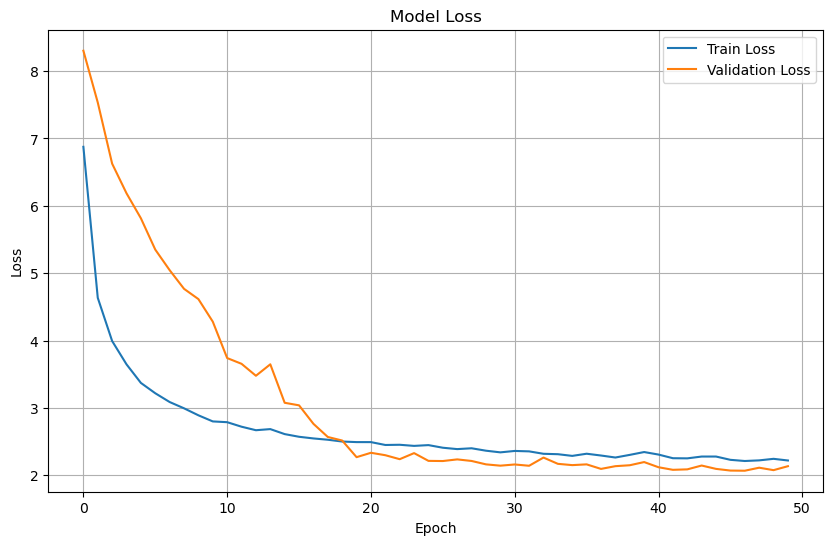
Prepare test dataset#
test_dataset = tf.data.Dataset.from_tensor_slices((X_test, y_test))
test_dataset = test_dataset.batch(4)
# Evaluate the model on the test dataset
test_loss, test_mae = model.evaluate(test_dataset)
print(f"Test Loss: {test_loss}")
print(f"Test MAE: {test_mae}")
9/9 ━━━━━━━━━━━━━━━━━━━━ 1s 47ms/step - loss: 0.9987 - masked_mae: 0.9853
Test Loss: 0.9930378198623657
Test MAE: 0.9262827634811401
Make some maps of our predictions#
import numpy as np
import matplotlib.pyplot as plt
# Example: date to predict
date_to_predict = np.datetime64("2020-09-02")
# Get index of that date
available_times = data_xr["time"].values
date_index = np.where(available_times == date_to_predict)[0][0]
# Prepare input (X: shape = [time, lat, lon, n_features])
input_data = X[date_index] # shape = (lat, lon, n_features)
input_data = np.array(input_data) # convert to numpy
# Predict
predicted_output = model.predict(input_data[np.newaxis, ...])[0]
predicted_output = predicted_output[:, :, 0] # shape = (lat, lon)
# True value from y
true_output = y[date_index]
# Mask land (land_mask = ~ocean)
land_mask = dataset["ocean_mask"].values == 0.0
predicted_output[land_mask] = np.nan
true_output = np.where(land_mask, np.nan, true_output)
# Plot
vmin = np.nanmin([true_output, predicted_output])
vmax = np.nanmax([true_output, predicted_output])
plt.imshow(true_output, vmin=vmin, vmax=vmax, cmap='viridis')
plt.colorbar()
plt.title(f"True CHL on {date_to_predict}")
plt.show()
plt.imshow(predicted_output, vmin=vmin, vmax=vmax, cmap='viridis')
plt.colorbar()
plt.title(f"Predicted CHL on {date_to_predict}")
plt.show()
1/1 ━━━━━━━━━━━━━━━━━━━━ 0s 179ms/step
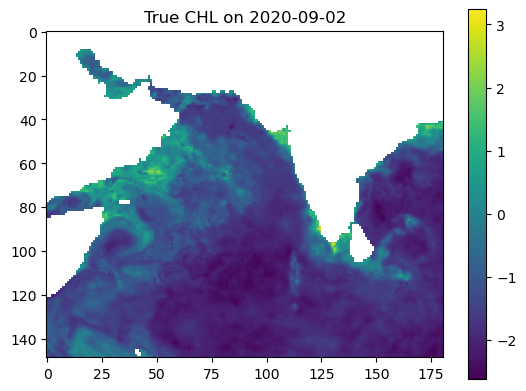
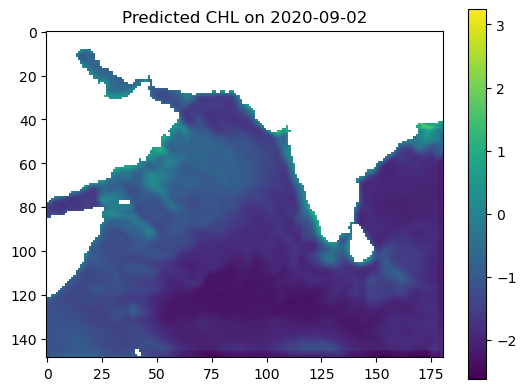
Let’s look at all the months#
First we will create a function that takes our model, the normalizing X_mean and X_std, the year to use and then makes plots of true versus predicted. We need to use X_mean and X_std from our training data. This was returned by time_series_split() above.
import matplotlib.pyplot as plt
import numpy as np
import pandas as pd
from sklearn.metrics import r2_score
def plot_true_vs_predicted(data, year, model, X_mean, X_std, num_var, cat_var):
"""
Plot true vs predicted output for first available day of each month in data_test.
Parameters:
data (xarray.Dataset): Contains variables 'y', 'ocean_mask', and coords 'lat', 'lon', 'time'
year (string in format XXXX): The year to use.
model (tf.keras.Model): Trained model with a .predict() method
X_mean (np.ndarray): mean from the model training data (num_vars only)
X_std (np.ndarray): std from the model training data
num_var (np.ndarry): The variables to be standardized with `X_mean` and `X_std`
cat_var (np.ndarry): The variables to be included in X, y but not standardized.
"""
data_test = data.sel(time=year)
# Get available time points and group by month
available_dates = pd.to_datetime(data_test.time.values)
monthly_dates = (
pd.Series(available_dates)
.groupby([available_dates.year, available_dates.month])
.min()
.sort_values()
)
n_months = len(monthly_dates)
# lat/lon info
lat = data_test.lat.values
lon = data_test.lon.values
extent = [lon.min(), lon.max(), lat.min(), lat.max()]
flip_lat = lat[0] > lat[-1]
land_mask = data_test["ocean_mask"].values == 0.0
# only normalize num_var
split_ratio = (0.0, 0.0, 1.0)
X, y, *_ = time_series_split(data_test, num_var, cat_var, split_ratio, X_mean=X_mean, X_std=X_std)
# Create figure and axes
fig, axs = plt.subplots(n_months, 2, figsize=(7, 2 * n_months), constrained_layout=True)
for i, date in enumerate(monthly_dates):
date_index = np.where(available_dates == date)[0][0]
# True output
true_output = data_test['y'].sel(time=date).values
if flip_lat:
true_output = np.flipud(true_output)
# Prediction
input_data = np.array(X[date_index])
predicted_output = model.predict(input_data[np.newaxis, ...])[0]
predicted_output = predicted_output[:, :, 0]
predicted_output[land_mask] = np.nan
if flip_lat:
predicted_output = np.flipud(predicted_output)
# Shared color scale
vmin = np.nanpercentile([true_output, predicted_output], 5)
vmax = np.nanpercentile([true_output, predicted_output], 95)
# Compute R² and RMSE
true_flat = true_output.flatten()
pred_flat = predicted_output.flatten()
valid_mask = ~np.isnan(true_flat) & ~np.isnan(pred_flat)
r2 = r2_score(true_flat[valid_mask], pred_flat[valid_mask])
rmse = np.sqrt(np.mean((true_flat[valid_mask] - pred_flat[valid_mask]) ** 2))
# Plot true
axs[i, 0].imshow(true_output, origin='lower', extent=extent,
vmin=vmin, vmax=vmax, cmap='viridis',
aspect='equal')
axs[i, 0].set_title(f"{date.strftime('%b')} — True", fontsize=10)
axs[i, 0].axis('off')
# Plot predicted
axs[i, 1].imshow(predicted_output, origin='lower', extent=extent,
vmin=vmin, vmax=vmax, cmap='viridis',
aspect='equal')
axs[i, 1].set_title(f"{date.strftime('%b')} — Pred\n$R^2$ = {r2:.2f}, RMSE = {rmse:.2f}", fontsize=10)
axs[i, 1].axis('off')
plt.suptitle('CHL: True vs Predicted (log scale) '+year, fontsize=16)
plt.show()
Make the plot#
This is the first available day. Note there is missing salinity data for 2021 and 2022 so only test on 1997 to 2020. 2020 was used for training so I pick a year that is not 2020.
plot_true_vs_predicted(dataset, "2010", model, X_mean, X_std, num_var, cat_var)
1/1 ━━━━━━━━━━━━━━━━━━━━ 0s 18ms/step
1/1 ━━━━━━━━━━━━━━━━━━━━ 0s 18ms/step
1/1 ━━━━━━━━━━━━━━━━━━━━ 0s 18ms/step
1/1 ━━━━━━━━━━━━━━━━━━━━ 0s 18ms/step
1/1 ━━━━━━━━━━━━━━━━━━━━ 0s 17ms/step
1/1 ━━━━━━━━━━━━━━━━━━━━ 0s 18ms/step
1/1 ━━━━━━━━━━━━━━━━━━━━ 0s 17ms/step
1/1 ━━━━━━━━━━━━━━━━━━━━ 0s 17ms/step
1/1 ━━━━━━━━━━━━━━━━━━━━ 0s 18ms/step
1/1 ━━━━━━━━━━━━━━━━━━━━ 0s 18ms/step
1/1 ━━━━━━━━━━━━━━━━━━━━ 0s 17ms/step
1/1 ━━━━━━━━━━━━━━━━━━━━ 0s 18ms/step

Look at R2 over years#
Start by creating a function.
import matplotlib.pyplot as plt
import numpy as np
import pandas as pd
from sklearn.metrics import r2_score, mean_absolute_error
import calendar
def plot_metric_by_month(data, years, model, X_mean, X_std, num_var, cat_var,
training_year=None, metric='r2'):
"""
Plot a selected evaluation metric (R², RMSE, MAE, or Bias) by month for each year.
Parameters:
data (xarray.Dataset): Contains 'y', predictors, and coordinates
years (list of str): Years to evaluate, e.g., ['2018', '2019', '2020']
model (tf.keras.Model): Trained model with .predict() method
X_mean, X_std (np.ndarray): Normalization stats for num_vars
num_var, cat_var (list of str): Variable names
training_year (str, optional): If specified, highlights that year specially
metric (str): One of ['r2', 'rmse', 'mae', 'bias']
"""
assert metric in ['r2', 'rmse', 'mae', 'bias'], "Invalid metric. Choose from 'r2', 'rmse', 'mae', 'bias'."
metric_by_year_month = {}
for year in years:
data_year = data.sel(time=year)
dates = pd.to_datetime(data_year.time.values)
monthly_dates = (
pd.Series(dates)
.groupby([dates.year, dates.month])
.min()
.sort_values()
)
split_ratio = (0.0, 0.0, 1.0)
X, y, *_ = time_series_split(data_year, num_var, cat_var, split_ratio, X_mean=X_mean, X_std=X_std)
metric_scores = []
for date in monthly_dates:
idx = np.where(dates == date)[0][0]
true_output = data_year['y'].sel(time=date).values
pred_input = np.array(X[idx])
pred_output = model.predict(pred_input[np.newaxis, ...], verbose=0)[0][:, :, 0]
pred_output[data_year["ocean_mask"].values == 0.0] = np.nan
mask = ~np.isnan(true_output) & ~np.isnan(pred_output)
y_true = true_output[mask].flatten()
y_pred = pred_output[mask].flatten()
if metric == 'r2':
score = r2_score(y_true, y_pred)
elif metric == 'rmse':
score = np.sqrt(np.mean((y_true - y_pred)**2))
elif metric == 'mae':
score = mean_absolute_error(y_true, y_pred)
elif metric == 'bias':
score = np.mean(y_pred - y_true)
metric_scores.append(score)
metric_by_year_month[year] = (monthly_dates.dt.month.values, metric_scores)
# Plotting
plt.figure(figsize=(10, 5))
for year, (months, scores) in metric_by_year_month.items():
label = f"{year} (train)" if year == training_year else year
style = "--" if year == training_year else "-"
plt.plot(months, scores, style, marker='o', label=label)
plt.xlabel("Month")
plt.ylabel({
'r2': "$R^2$",
'rmse': "RMSE",
'mae': "MAE",
'bias': "Bias"
}[metric])
plt.title(f"Monthly {metric.upper()} by Year")
plt.xticks(np.arange(1, 13), calendar.month_abbr[1:13])
plt.legend()
plt.grid(True)
plt.tight_layout()
plt.show()
plot_metric_by_month(dataset, ['2000', '2005', '2010', '2015', '2020'], model, X_mean, X_std, num_var, cat_var, training_year="2020")
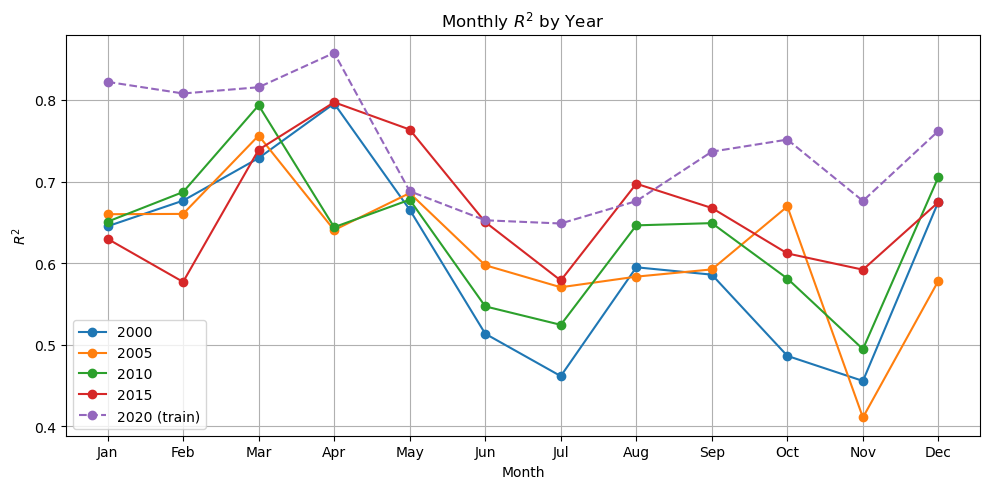
plot_metric_by_month(dataset, ['2000', '2005', '2010', '2015', '2020'], model, X_mean, X_std, num_var, cat_var, training_year="2020", metric="bias")
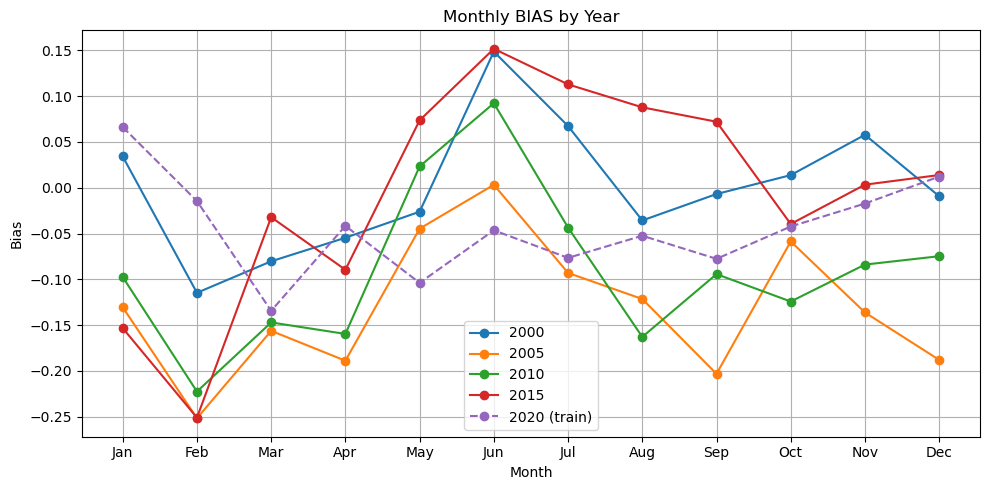
plot_metric_by_month(dataset, ['2000', '2005', '2010', '2015', '2020'], model, X_mean, X_std, num_var, cat_var, training_year="2020", metric="mae")
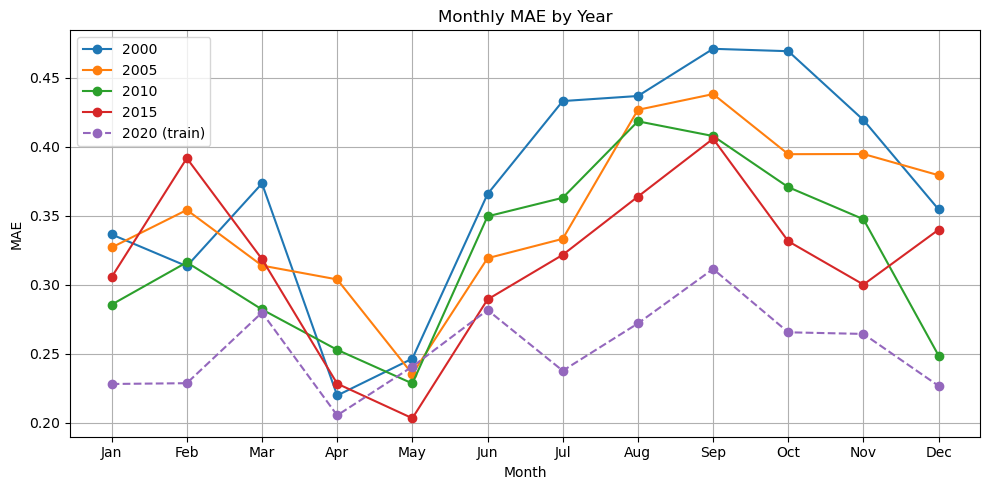
Summary#
Now we have a model that is doing ok. It still doesn’t pick up the upwelling zone at the southern tip of India too well however. There is something about that area that is different and that the model is unable to learn. We should look into what drives that upwelling zone. It maybe that the relationship between SST and salinity are different there. It pokes down into a strong E-W current system.
Also the out of training years shows big variation in performance by season which suggests that we need to train on more years (more seasons).
We used the full region as the input shape for learning. What might have happened is that the model learned where and when in the region CHL tends to be high and low. But it might not have used SST and salinity at all and it might, therefore, have a hard time generalizing to other years. Note it is unlikely that this model would generalize to other regions as the SST and salinity associations are very specific to the oceanography and ocean biochemistry of the region.
In Part III, we will try different size patches.



